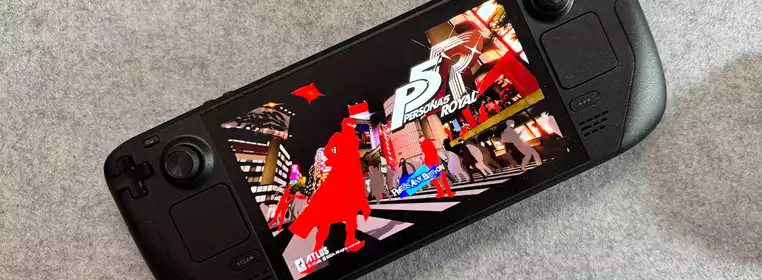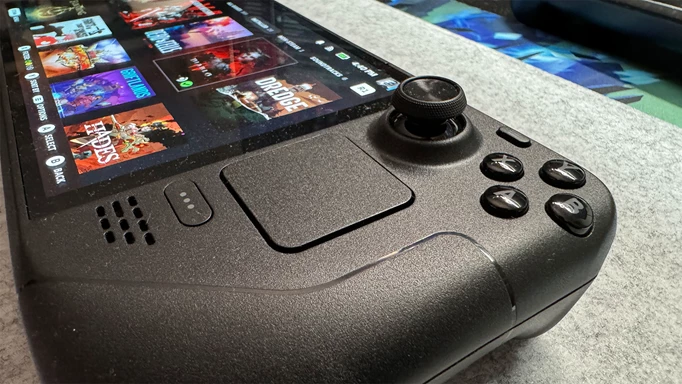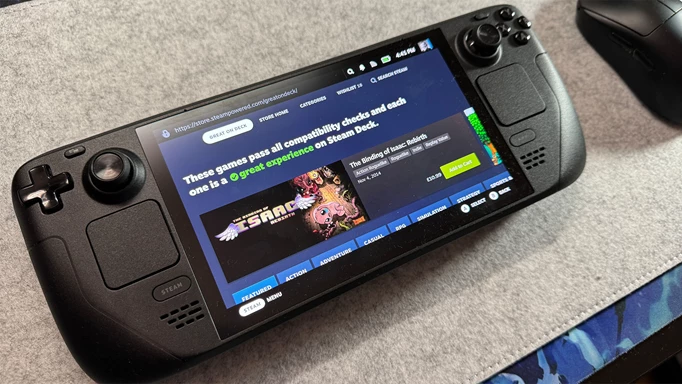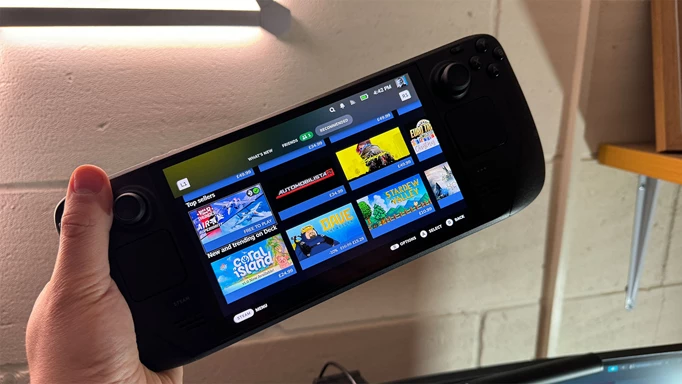Steam Deck OLED review: More than the sum of its already excellent parts

There comes a time in a reviewer’s life when a product crosses your (virtual) desk and feels like an easy one to cover. The new iPhone doesn’t shake up a lot of what the iPhone does. Xbox Series X is still an Xbox. And the Steam Deck OLED is still a Steam Deck.
That may sound like a criticism, but after spending a few days with the latest version of Valve’s handheld PC, I’m struck by just how much more has changed. It’s more than the sum of its upgrades, and puts Valve back on top of the pile at a time when more and more competitors are entering the fray.
GGRecon Verdict
The list of complaints I had with the Steam Deck LCD was short, but the OLED handily bats them away. It’s brighter, lighter, and lasts longer, and still feels like the easiest portable PC to recommend thanks to its ease of use and game designations.
While it may not overhaul the idea of what a Steam Deck can do, it does it so much better than its predecessor that I’m itching to go pick it up again.
What’s on Deck?

 Click to enlarge
Click to enlargeFrom the outside, it’s a little hard to tell what’s changed with the Steam Deck OLED, outside of some subtle tweaks. The thumbsticks are emblematic of the console refresh as a whole; they’ve been quietly upgraded to offer more grip and be smoother to move, and yet barely get a mention on Valve’s product page.
Naturally, your eyes are drawn to that OLED panel, though, and it’s still packing the 1280x800 resolution, although it’s slightly bigger on the OLED without increasing the footprint thanks to smaller bezels (7.4 inches versus 7 inches). The bezels always felt a little retro on my LCD Steam Deck, so I’m glad to see them trimmed down a little here.
The screen also has a 90Hz refresh rate, up from the LCD version’s 60Hz, and while naturally the higher you push your frame rates, the faster you’ll drain your battery, it’s here that my favourite upgrade comes in - 30 - 50% more battery life than the previous model.
That’s thanks to a more efficient AMD chip and bigger battery, and while I wasn’t expecting to get particularly excited about it, the results speak for themselves.
I played Monster Hunter World, locked to 40 frames-per-second, and drained almost all of my battery while playing for an hour and 15 minutes on my LCD Steam Deck. On the OLED, I reached around 2 hours. That’s a sizeable amount more playtime, and it’ll last much longer with non-AAA titles.
Knowing the Steam Deck OLED simply has more juice to offer than its older sibling meant I was reaching for it much more often than I did the LCD version, grabbing it for a quick Diablo 4 dungeon or a Hades run. And when it is time to charge, the 45W power adapter now has a 2.5m cable instead of a 1.5m one, and it has a logo on it now, if that’s the kind of thing you’re into.
I’ve seen OLED panels on everything from phones to the Switch, but Valve’s implementation, with HDR, really is staggering here. Firing up a colourful title like Persona 5 Royal, an amazing showcase of vibrancy and deep blacks, or underrated mech shooter Daemon X Machina with its kaleidoscope of colours, is a treat.
Hollow Knight looks staggering on the OLED, too, but perhaps most impressive was how much Elden Ring’s Lands Between map felt like it was given new life. Small touches like Sites of Grace standing out more against the green and brown of Limgrave, or the brighter torches in caves make it feel even more staggering FromSoft’s Game of the Year can be played in your hands.
When is a PC a console?

 Click to enlarge
Click to enlargeEnough comparison, though - what exactly does the Steam Deck offer for your money? In short, it’s still the most polished handheld PC experience around.
Open the package (including the lovely carry case included with the 1TB model I was sent for review), connect to your Wi-Fi and log into Steam. It’s really that simple, and you’ll be able to download your games (and do so faster than ever with Wi-Fi 6E support).
Valve’s team has painstakingly curated Steam’s thousands of titles to identify the best ones for Deck with a green designation, while others are deemed ‘playable’, perhaps with caveats like small text or needing to use an on-screen keyboard.
Some, like VR titles, are unsupported entirely, and the number of untested games shrinks regularly. I got my Steam Deck LCD last Summer and it’s been amazing to see how many games since then have launched with Steam Deck compatibility, or that Valve has added to the list. Some have even changed designations - Metal Gear Solid V: The Phantom Pain went from “Great on Deck” to “Playable”, for example. It's not a perfect system (Dead Space Remake is dubbed as "Great on Deck" but struggles to run at all), but it's a way better experience than what rivals offer.
It’s this ownership of its ecosystem that makes the Steam Deck more attractive than many similar handheld PCs like the (also excellent) Asus ROG Ally. SteamOS provides a more console-like experience, meaning installing games from Steam is easy, and so is adjusting more technical settings.
That’s a double-edged sword, though, since Linux, which offers the backbone for SteamOS (and is accessible via its own ‘Desktop Mode’) doesn’t support certain anti-cheat or allow some games to be played. Notable exceptions are Destiny 2, Modern Warfare 3 and Lost Ark, three games I’ve put plenty of time into on Steam but simply cannot play on the Deck.
It’s possible to install other storefronts with some fiddling, and it’s relatively simple to get things like the Epic Game Store running, but you still won’t be able to jump into the likes of Fortnite since the anti-cheat isn’t supported. Long story short, if you’ve got a huge Steam library, the Deck OLED is the best way to go, but if you’re looking for any of the exceptions I’ve listed here, you may want to look at a Windows-based alternative.
Thankfully there’s an awful lot to choose from on Steam, and with the OLED Steam Deck starting at 512GB (Valve has thankfully discontinued the 64GB version) there’s a lot more storage to play it - plus microSD card support makes it easy to expand that further.
Play nice

 Click to enlarge
Click to enlargeWhile the Steam Deck remains considerably larger than something like the Switch’s own OLED version, it has shaved off 30g with this hardware revision. Regardless, the main form factor has barely changed at all, but that’s no bad thing - as someone with larger-than-normal hands I’m pleased to find the shoulder buttons trigger more consistently, and it remains comfortable for long periods.
Those back buttons remain something I tend to skip over, but as far as customizable buttons go, you can use SteamOS to have them act just about anything. The touchpads are back, but haptics are improved now - I thought they felt great beforehand, but there’s much more nuance to vibration from them now.
Are there any performance benefits to buying an OLED version, though? Sort of. Naturally, the display’s higher frame rate threshold is very handy indeed, helping push games to be smoother, and you may eke an extra frame or two out of some titles without it.
If you’re expecting big strides, though, you’ll want to keep an eye out for the inevitable Steam Deck 2 - although Valve has suggested that’s some way off. Improved thermals do mean the Steam Deck OLED runs cooler, though.
Is it worth upgrading?
As someone who’s dumped a whole lot of hours into playing on my LCD Steam Deck, I feel it’s worth noting that while the Steam Deck OLED isn’t likely to be an instant purchase for current owners, if you do any travelling it may make a case for it.
The screen is transformative, sure, but arguably the better battery is the bigger boon, letting you feasibly play the likes of Cyberpunk 2077 on the bus without it running out of juice before you reach your stop. The rest of the improvements certainly don’t hurt, either.
The Verdict
The list of complaints I had with the Steam Deck LCD was short, but the OLED handily bats them away. It’s brighter, lighter, and lasts longer, and it still feels like the easiest portable PC to recommend thanks to its ease of use and game designations.
While it may not overhaul the idea of what a Steam Deck can do, it does it so much better than its predecessor that I’m itching to go pick it up again.
5/5
Review unit provided by the manufacturer. For more on the Steam Deck OLED, be sure to check out our favourite games for the system.
